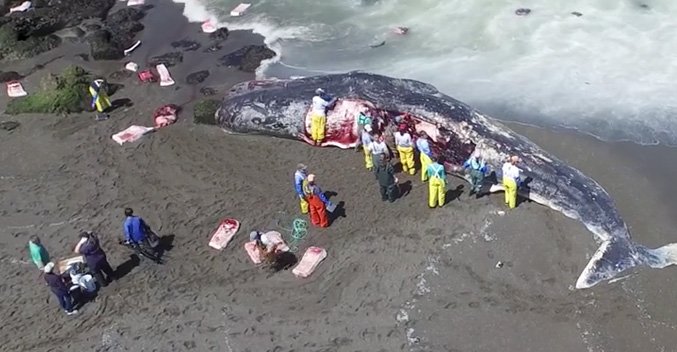
A necropsy is performed on a large adult sperm whale in Pacifica. Image source: Duncan Sinfield, Youtube screenshot (see video below)
For the second time in less than a month, a dead whale has washed ashore in Pacifica, about 15 miles south of San Francisco. The second whale, a young female humpback, was discovered on Monday, just half a mile from where the first whale was discovered.
The latest whale was spotted on Monday at Sharp Park State Beach, and is again drawing crowds of onlookers taking photos. Fortunately, it appears that both standings are natural events and not a part of an epidemic.
Sue Pemberton with the California Academy of Sciences was out at the beach Tuesday morning and told NBC Bay Area News that she doesn’t think there’s anything particularly wrong with the ocean, or that there is an epidemic of dead whales. “I think it’s a coincidence,” she said. “They are two different species and age classes. There are pretty strong onshore winds at this beach, and it lends itself to being a repository for dead marine mammals and garbage. I’m not surprised. Animals die.”
The first whale was an adult sperm whale, about twice the size of the younger female humpback. A necropsy was performed on the sperm whale and nothing conclusive was found to indicate why it died. 17 dead sperm whales have washed up on California’s northern coast in the 40 years, according to the Marine Mammal Center in Sausalito.
Regardless of the cause, nearby residents and visitors to this seaside town aren’t happy about the smell. Thousands of pounds of rotting flesh remain on the beach from the sperm whale, causing a horrific odor in the area. The whale hasn’t been moved, reportedly because no jurisdiction has yet to claim it. There is a dispute as to whether the first whale’s body lies on the property of the city of Pacifica, the Golden Gate National Recreation Area, the city and county of San Francisco’s Recreation and Park District, or the state of California. Once a ruling is made, it will then be decided who will move the whale, and how. Scientists at the National Oceanic and Atmospheric Administration said the best thing to do is to tow the whale back out in the ocean, but at this point, it may be too late, he said, because the carcass of the sperm whale is deeply embedded in the sand.
